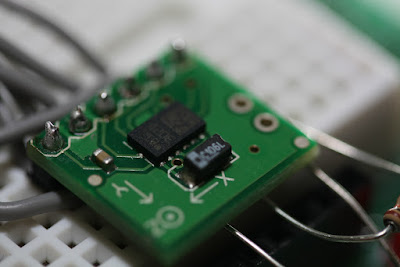Consumer electronics are electronic equipment used in day-to-day
life, such as flat screen TVs, smart phones, personal computers, laptops, and
others. Sensors play a crucial role in efficient operation of these devices.
Increasing demand of customers for superior quality, slim design, high energy
efficiency, and other features have enforced manufacturers to incorporate
sensors in consumer electronic devices. Various sensors, such as temperature
sensor , speed sensor, electronic sensors, and others have been installed inside
laptops, smartphones, game consoles, and other devices to provide enriching
experience and convenience to users.
 |
| https://www.flickr.com/photos/randomskk/3282729421 |
Various sensors in smartphones :
There are various
sensors used in smartphones that provide ease-of-use and security to users.
The most basic sensor used in smartphone is accelerometer , which determines the
orientation of device among three axes and rotates screen in portrait or
landscape mode. Gyroscope also provides information about orientation, but with
more precision than accelerometer. Few high-end devices have barometer , a
sensor that measures atmospheric pressure and determines the distance above sea
level, which in turn, results in enhanced GPS accuracy. A light sensor measures
the brightness of ambient light and adjusts the brightness of display . A
proximity sensor, which is placed at the earpiece of a phone, sends information
to system that user is attending a call and display screen is turned off by
system to save energy.
Get access to detailed report at:https://www.alliedmarketresearch.com/sensors-in-consumer-electronics-products-market
Apple’s technology
and acquisition of patents:
Touch ID
on iPhone and iPad enables users to unlock devices with their fingerprints.
A user places finger on Home Button and a sensor residing underneath that
button determines whether fingerprint matches with stored data. Home Button is
made up of sapphire crystal that protects sensor and acts as a lens. Sensor
used in Touch ID scans the details of fingerprint with precision and creates a
mathematical representation. Then, it compares this representation with stored
data to identify the match and unlock the device. In this way, sensors can be
used in consumer electronics for security purposes.
Apple
has acquired 26 out of 31 original patents of Privaris, a biometric
technology firm. These patents are related to fingerprint and touchscreen technology.
The acquisition of patents aims to improve Touch ID on iPhone and iPad. Apple
is planning to eliminate physical Home Button and introduce a virtual Home
Button by creating a multi-touch display with the help of integrated
fingerprint technology. As per the reports from CNN, one of the patents
acquired from Privaris enable users to use fingerprint technology and
touchscreen at the same time. A fingerprint scanner residing beneath the screen
can scan the finger through phone’s display. In this way, Apple will be able to
create an iPhone with an edge-to-edge screen. Furthermore, Apple uses biometric
sensors for authentication to authorize credit card payments using its Apple
Pay service.
Windows Geosense:
The introduction of Geosense
consisting of sensors and location platform into Windows 7 enables it to
respond to environmental changes detected by light, GPS chips, or orientation
sensors. Location platform facilitates automatic location based search and maps
to PC. Geosense in Windows 7 uses IP lookup, WiFi & Cell tower
triangulation, and others to find location as precisely as possible. In
addition, location-aware applications are benefited from Geosense for
determination of location as it is listed as a sensor in the Windows Sensors
and Locations.
Intel’s developments:
Technological advancements in sensors have changed the way
personal computers (PC) and laptops operate. Intel
has replaced 2D cameras in PCs with RealSense 3D camera. This technology
detects objects and also measures the distance between them. Furthermore, Kinect-like
gesture recognition and motion sensing capabilities of camera takes PC gaming
experience to whole new level . The combination of gesture, voice, and visual
inputs plays a vital role in recognizing human moods and habits, which in turn,
makes interactions smarter and easier. Furthermore, Intel provides a software with
which logging into websites is possible using biometric authentication. This
software is useful for reliable & secure service and eliminates the need to
remember passwords for different websites. The inclusion of fingerprint readers
in PCs and laptops of Intel is a major step toward providing biometric
authentication.
A considerable growth in smartphones and tablets along with technological
advancements have driven the use of sensors in consumer electronics industry . Analysts
have presented thorough information on current market trends and developments
in the industry. Allied Market Research will publish a report titled, “World
Sensors in Consumer Electronics Market - Opportunities and Forecasts, 2014 –
2022.” The report offers a comprehensive analysis of current market trends,
detailed segmentation, SWOT analysis of key manufacturers, and quantitative
data on changing market trends, revenues, & market competition.

No comments:
Post a Comment